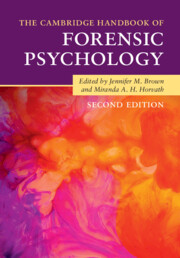Book contents
- The Cambridge Handbook of Forensic Psychology
- The Cambridge Handbook of Forensic Psychology
- Copyright page
- Dedication
- Contents
- Figures
- Tables
- Contributors
- Preface
- Forensic Psychology
- Part I Psychological Underpinnings
- Part II Psychology and Criminal Behaviour
- 2.1 Current Understandings of Sex-Based Harassment and Stalking Perpetration
- 2.2 The Behaviour of Sex Offenders
- 2.3 Intimate Partner Violence
- 2.4 Acquisitive Crime
- 2.5 Terrorism Research
- 2.6 Online Child Sexual Exploitation and Abuse
- 2.7 Arson
- 2.8 Serial Killings and Mass Murder
- Part III Assessment
- Part IV Interventions
- Part V Civil Proceedings
- Part VI Professional Practices
- Index
- References
2.2 - The Behaviour of Sex Offenders
from Part II - Psychology and Criminal Behaviour
Published online by Cambridge University Press: 02 December 2021
- The Cambridge Handbook of Forensic Psychology
- The Cambridge Handbook of Forensic Psychology
- Copyright page
- Dedication
- Contents
- Figures
- Tables
- Contributors
- Preface
- Forensic Psychology
- Part I Psychological Underpinnings
- Part II Psychology and Criminal Behaviour
- 2.1 Current Understandings of Sex-Based Harassment and Stalking Perpetration
- 2.2 The Behaviour of Sex Offenders
- 2.3 Intimate Partner Violence
- 2.4 Acquisitive Crime
- 2.5 Terrorism Research
- 2.6 Online Child Sexual Exploitation and Abuse
- 2.7 Arson
- 2.8 Serial Killings and Mass Murder
- Part III Assessment
- Part IV Interventions
- Part V Civil Proceedings
- Part VI Professional Practices
- Index
- References
Summary
This chapter explores the types of behaviour seen in sex offending. It covers how behaviour has been used to create typologies of offending, as well as how both internal factors – such as fantasy and offender characteristics, and external factors – such as the number of offenders present and the cultural influence on behaviour – can affect sex offender behaviour. It also explores how behaviour can be conceptualised as a pattern demonstrated across a series of offences, and the factors that can affect the consistency of this behaviour. Finally, this chapter outlines how our understanding of sex offender behaviour can contribute to the investigation, assessment, management, and treatment of sex offenders.
- Type
- Chapter
- Information
- The Cambridge Handbook of Forensic Psychology , pp. 195 - 217Publisher: Cambridge University PressPrint publication year: 2021

